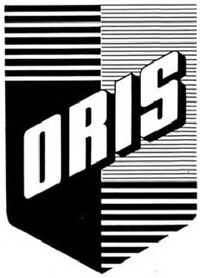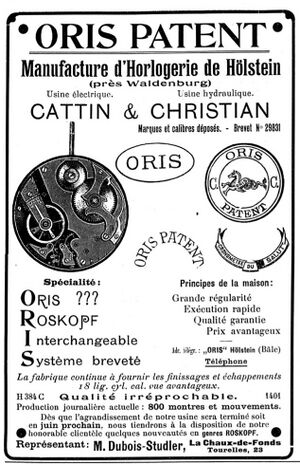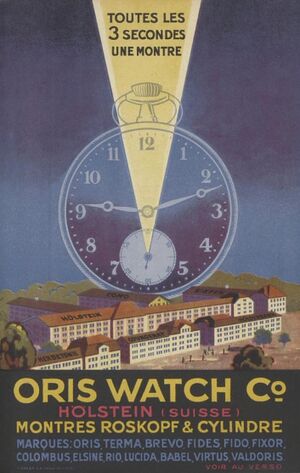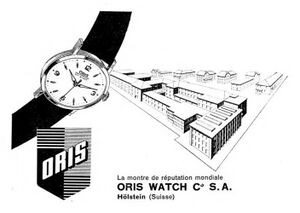Oris: Difference between revisions
| Line 23: | Line 23: | ||
One unusual pre-war product was the Lucida, a completely [[skeletonized]] watch. It was advertised as "mouvement transparent" from 1907 through 1909. Oris also appears to have sold a version (or perhaps an imitation) of the [[Hebdomas]] watch, with a visible balance and 8-hour power reserve, in 1909. The company also produced a "railroad" watch in the 1910s, though it is unlikely any railroad would have accepted a Roskopf movement in an official watch. By 1913 the company boasted annual production of 985,000 Roskopf watches. | One unusual pre-war product was the Lucida, a completely [[skeletonized]] watch. It was advertised as "mouvement transparent" from 1907 through 1909. Oris also appears to have sold a version (or perhaps an imitation) of the [[Hebdomas]] watch, with a visible balance and 8-hour power reserve, in 1909. The company also produced a "railroad" watch in the 1910s, though it is unlikely any railroad would have accepted a Roskopf movement in an official watch. By 1913 the company boasted annual production of 985,000 Roskopf watches. | ||
=== | ===Reorganization Following the Death of Georges Christian=== | ||
[[File:Davoine 1928 1024-1.jpg|right|thumb|300px|A 1928 ad showing the Hölstein factory]] | [[File:Davoine 1928 1024-1.jpg|right|thumb|300px|A 1928 ad showing the Hölstein factory]] | ||
When Christian suddenly died in [[1927]] ownership of the company passed to his widow Emilie Christian-Bürgy and young daughters, Germaine and Hélène. They were assisted by a group of watchmakers and businessmen friendly to the family, beginning with watchmaker [[Fritz Heid]]. [[Oscar Herzog]], Georges Christian's brother in law, became managing director with Louis Wolf and Karl Martin assuming management. | When Christian suddenly died in [[1927]] ownership of the company passed to his widow Emilie Christian-Bürgy and young daughters, Germaine and Hélène. They were assisted by a group of watchmakers and businessmen friendly to the family, beginning with watchmaker [[Fritz Heid]]. [[Oscar Herzog]], Georges Christian's brother in law, became managing director with Louis Wolf and Karl Martin assuming management. | ||
Revision as of 12:22, 9 October 2024

Oris is a Swiss watch manufacturer founded in 1902 in Hölstein.
History
Lohner & Nägelin
The factory used by Oris was founded in 1902 by a new firm named Lohner & Nägelin. In March of that year, Arnold Lohner-Leuenberger from Grindelwald and Wilhelm Nägelin from Reigoldswil entered into a partnership in Hölstein for the manufacture of watch components ("Fabrique d'Ebauches et de finissages Remontoir et a clefs"). The availability of automated tools and steam power lead to the rapid creation of many such factories at this time. Lohner brought watchmaking skills while Nägelin was a local investor.
Charles and Arnold Lohner had become involved in watchmaking by 1894, with Arnold becoming a partner with Albert Buser-Weber and Fritz Buser-Bieder as their company, Buser Frères of Niederdorf, expanded. The firm had recently opened an ebauche factory in Alsace, a move not supported by brother Johannes Busser-Tièche who left the company. They became embroiled in the workers' strike in Langendorf later that year, siding with Lucien Tièche, and were pulled into the controversy in the press in 1896. The company's Alsace operation was convicted of violating hallmark laws and copying Swiss movement designs. Lohner stayed with the company through all this but finally left in 1902 to start his own factory.
That same year the pair established a factory in Hölstein on the banks of the Frenke river. In 1903 the company registered the brand name Oris as a reference to this "aurisa" or "watercourse" and the name continues to this day. Nägelin left the factory soon after, and the company became known as Lohner & Cie. Wilhelm Nägelin continued to work to attract investors to various "safe investments" in the canton but appears to have found little success.
But it was more difficult than expected to staff the factory, located well outside the Jura triangle. No local workers had watchmaking skills, and only a few French-speaking workers were willing to relocate. Just two years after its founding, the Hölstein factory faced closure. It is often said that Arnold Lohner died in 1904 as well, though there is little evidence of this.
Cattin and Christian

In 1904 Paul Cattin and Georges Christian (1875-1927) took over the business. Christian was the technical director of the Société d'Horlogerie de Granges despite being just 29 years old. In 1917 Christian took full control of the factory, which he managed until his sudden death in 1927.
Under Georges Christian, Oris rapidly expanded operations. The firm opened five additional factories in Switzerland between 1906 and 1925, in Holderbank, Como, Courgenay, Ziefen, Herbertswil, and Bienne, and was the largest employer in Hölstein by 1910, with 300 workers.
One unusual pre-war product was the Lucida, a completely skeletonized watch. It was advertised as "mouvement transparent" from 1907 through 1909. Oris also appears to have sold a version (or perhaps an imitation) of the Hebdomas watch, with a visible balance and 8-hour power reserve, in 1909. The company also produced a "railroad" watch in the 1910s, though it is unlikely any railroad would have accepted a Roskopf movement in an official watch. By 1913 the company boasted annual production of 985,000 Roskopf watches.
Reorganization Following the Death of Georges Christian

When Christian suddenly died in 1927 ownership of the company passed to his widow Emilie Christian-Bürgy and young daughters, Germaine and Hélène. They were assisted by a group of watchmakers and businessmen friendly to the family, beginning with watchmaker Fritz Heid. Oscar Herzog, Georges Christian's brother in law, became managing director with Louis Wolf and Karl Martin assuming management.
A few months later, a new Société Anonyme was formed to take over the assets of the company, which had previously been a closely-held sole proprietorship of Georges Christian alone. Compagnie des Montres Oris SA was formed on June 26 and 29 with share capital of 1 million francs, with 800,000 in shares and the rest in credit notes. The board consisted of president Georg Stadler, widow Emilie Christian-Bürgy, Oscar Herzog-Christian, Fritz Heid, architect Constant-Bernard Rossier, noted watchmaker Jacques-David LeCoultre, and lawyer Dr. Alfred Veit-Gysin. Hermann Portmann joined the board in 1930, bringing another important family name into the firm.
Share capital was increased to 1.5 million francs following the issue of 500 new shares on September 30, 1930. In June of 1935 Fritz Heid and Constant-Bernard Rossier left the board, with Alfred Liechti-Christian and Dr. Fritz Heer joining. They were the husbands of Georges Christian's daughters, Germaine and Hélène, respectively. Hélène Heer-Christian would take her husband's seat in 1947 and Germaine Liechti-Christian would take her husband's seat a decade later. Following the death of board president Georg Stadler, Emilie Christian-Bürgy took over as president of the firm in March 1936, with Alfred Liechti-Christian becoming secretary.

Share capital was increased to 1.62 million francs following new investment on March 18, 1940, showing continued strength of the firm. In January 1942 Jacques-David LeCoultre replaced widow Emilie Christian-Bürgy as president, though she remained on the board. LeCoultre would guide the firm through World War II, changing its name to Oris Uhrenfabriken A.G. (Compagnie des Montres Oris S.A.) (Oris Watch Co. Ltd.) in December 1943.
Oris specialized in inexpensive alarm clocks through World War II but continued development of inexpensive watches as well. As early as 1930 the daily production reached about 7000 watches. They were sold to Europe, New Zealand, South America and China.
Post-War Development
In July of 1946, Willy Herzog was appointed deputy director with Hermann Portmann joining him the following April. Alfred Golay from Le Chenit joined the firm, likely brought in by LeCoultre, at this time.
In September 1948, Jacques-David LeCoultre resigned from the Board of Directors, with widow Emilie Christian-Bürgy returning to the role of president. Willy Herzog joined the board at this time as well.
The company launched an automatic watch in 1952.
Until 1960 Oris manufactured only watches with pin-lever escapement (Roskopf movement). In 1956, Rolf Portmann was hired by Oscar Herzog to challenge the control of the Swiss watchmaking cartel, which forced the company to produce only pin lever movements. In 1945 the company successfully participated in chronometer tests of the Swiss testing laboratory and till 1958 received approximately 1,500 chronometer certificates for its wristwatches.
Oris specialized in pin lever movements and was able to achieve exceptionally high quality and accuracy. In 1953, 113 Oris watches were sent to Le Locle obtain a Chronometer certification, the first time pin lever watches were able to achieve this. The company sued to relax the strict controls on companies producing new competitive anchor movements and was able to succeed in getting these restrictions lifted in 1966.

In the sixties Oris was one of the ten largest watch manufacturers in Switzerland. From 20 employees originally, Oris grew to 668 employees in 1953 and 770 in 1965.
Oris produced its first lever escapement watch movement, the automatic Cal. 645, in 1966. In 1968 the firm received its first chronometer certificate for a watch using the in-house Cal. 652.
In 1969, just as the automatic chronograph appeared, Oris introduced its own counter-less chronograph, the ChronOris. Produced with Dubois Dépraz, the 27.50 mm Cal. 725 was a modular movement, with a 2 mm thick column wheel chronograph and date complication on a simple base. Although it appears to have a second pusher, this is a crown used to control an interior rotating bezel. In all 27,000 examples of the ChronOris were manufactured.
Oris produced 1.2 million watches in 1969, the peak of production. But the company was sold to ASUAG in 1970.
Emphasis on traditional mechanical watches
In 1982 the Oris SA was re-established under the leadership of Rolf Portmann and Ulrich Herzog. It was one of the very first manufacturers who completely emphasized on traditional mechanics. The dials of the watches were sometimes intricately guilloched and together with the curved hands were significantly inspired by classical examples. With the slogan "High Mech" the importance of traditional mechanics was emphasised, in contrast to quartz technology, which in those days was still present even in the luxury segment. A complex, freely distributed catalog book documented history and technique of traditional watchmaking mechanics and positioned the brand clearly in this area. With this strategy it had success even in Japan. Among the classics of the brand is the model Big Crown, a pilot's watch with oversized crown, allowing the pilot to operate even with leather gloves.
Oris produced a watch with a date pointer in 1984. Based on a classic watch from the 1930s, this would become a signature Oris model. In 1988 the firm produced a mechanical alarm watch using an old A. Schild ebauche. After 1992 Oris focused entirely on mechanical watches.
Reorientation on masculine sports watches
At the end of the 1990 years the company with the new model series XXL and a TT1 reorientated towards large, heavy and conspicuous sports watches with masculine design. The model range was widely changed, and only the current version of the Big Crown still contains echoes of the earlier style. In order to increase their awareness one invested in new product lines, and a strong corresponding advertising. New distinguishing mark was now the red rotor of the mostly ETA-based automatic watch movements, which was visible through the transparent caseback. One of the most prestigious projects is the newer model TT1 Meistertaucher (Master Diver) - it is waterproof up to depths of 1,000 meters.
Since 2003 Oris occurs as a sponsor of the Formula 1 team Williams. In honor of Ralf Schumacher and the Williams F1 team a limited edition was launched. The watches of this edition included a carbon dial bearing the signature of Ralf Schumacher. A used part from the gearbox or the engine of an F1 car was added to each watch.
The sale of shares of the different continents reflect the success of the brand in the East: Europe 40%, Asia 47%, 9% Americas, Oceania 3% (in 2009). Since the Financial Crisis from 2007 Oris, relative to other providers, increases also much on the German market.
Overview of the Collection
The Oris collection includes the ranges Motor Sports, Aviation, Diving and Culture. In the latter, there are classic models as well as the series Miles, designed for famous jazz musicians, which is complemented by a special model for Bob Dylan.
Motor Sports
- TT3 Chronograph
- Chronoris, chronograph in the style of the 1970s
- Partnership with WilliamsF1:
Aviation
- Big Crown, model classic
- Flight Timer
- Hunter
Diving
Culture
Special Editions
- Oris TT3 Formula Gold LE, motor sports chronograph
- Col Moschin Limited Edition, dive watch / special operations watch
Address
Oris SA
Ribigasse 1
CH 4434 Hölstein
Tel. +41-61-9561111
Fax +41-61-9512065
Timeline
Prior Firms
- 1894, February - Jules Arnold Lohner-Leuenberger joins the existing Niederdorf firm of Albert Buser-Weber and Fritz Buser-Bieder, which is renamed Gebrüder Buser & Lohner
- 1902, January 1 - Lohner leaves the Buser brothers to start his own watch factory in Hölstein
- 1902, March 7 - Arnold Lohner-Leuenberger from Grindelwald and Wilhelm Nägelin from Reigoldswil enter into a partnership under the company Lohner & Nägelin in Hölstein for the manufacture of watch components ("Fabrique d'Ebauches et de finissages Remontoir et a clefs")
- 1903, March 7 - Lohner & Nägelin register the brand name "Oris"
- 1903, April 1 - The firm of Lohner & Nägelin is dissolved, replaced by "Lohner & Cie"; Arnold Lohner and Wilhelm Nägelin remain unlimited partners with Ernst Hartmann Utzinger from Wald investing 20,000 francs and becoming a limited partner and power of attorney
- 1903, July 1 - Wilhelm Nägelin resigns from the company
Cattin and Christian
- 1904, June 1 - Paul Cattin from Les Bois and Georges Christian from Le Locle, both living in Hölstein, enter into a collective partnership under the name Manufacture d'Horlogerie de Hölstein Cattin und Christian
- 1904, December 24 - Lohner & Cie is deleted from the commercial register
- 1907, May 1 - Hermann Rosskopf from Hertingen, Georges Christian from Locle, and Paul Cattin from Les Bois register the firm H. Rosskopf & Co. in Hölstein; Christian and Cattin are authorized representatives while Rosskopf is not
- 1908, February 1 - A branch of Manufacture d'Horlogerie de Hölstein Cattin & Christian is registered in Holderbank under Cattin and Cristian
- 1916, September - The owner of the company Uhrenfabrik Moderna Basel Paul Cattin in Basel is Paul Félicien Cattin-Rudolf from Les Bois, residing in Basel
- 1917, March 1 - A branch of Cattin & Christian is established in Courgenay
- 1918, January - The firm Manufacture d'Horlogerie de Hölstein Cattin & Christian in Hölstein has been dissolved; assets and liabilities are taken over by the new firm, Georges Christian, Uhrenfabrik Oris in Hölstein; Georges Christian from Le Locle, residing in Hölstein, is the owner; Louis Wolf from Lotzwil and Karl Martin from Frenkendorf are given power of attorney
- 1918, March - The Holderbank branch of Cattin & Christian is also taken over by Georges Christian
- 1918, April - The Courgenay branch of Cattin & Christian is also taken over by Georges Christian with Louis Wolf and Charles Martin
- 1922, December - Oscar Herzog of Wittnau is added as power of attorney in the firm
Oris SA
- 1928, January - Following the sudden death of Georges Christian, the firm of Georges Christian Uhrenfabrik Oris passes to his heirs and is now officially called Georges Christian Erben, Uhrenfabrik Oris; the inheritors are Mrs. Emilie Christian-Bürgy from Le Locle and her two underage daughters, Germaine and Hélène, both represented by Fritz Heid, watch manufacturer from Arisdorf; Oskar Herzog-Christian from Wittnau is given management authority while Louis Wolf from Lotzwil and Karl Martin from Frenkendorf are given signing authority
- 1928, July - Compagnie des Montres Oris SA is formed to take over "Georges Christians Erben, Uhrenfabrik Oris"; share capital is 1 million francs, with 800,000 in shares and the rest in credit notes; the board consists of Georg Stadler from Mettlen, widow Emilie Christian-Bürgy from Le Locle, Oscar Herzog-Christian from Wittnau, Fritz Heid from Arisdorf, architect Constant-Bernard Rossier from Villarzel, Jacques-David LeCoultre from Le Chenit, and lawyer Dr. Alfred Veit-Gysin from Basel
- 1930, January - A collective power of attorney is given to to Hermann Portmann from Flühli
- 1930, September 30 - Share capital is increased from 1 million francs to 1.5 million francs following the issue of 500 shares
- 1931, September 22 - The proxy granted to Willy Poppitz has expired
- 1935, June - Fritz Heid and Constant-Bernard Rossier have left the board; Newly elected members of the Board of Directors are Alfred Liechti-Christian from Basel and Dr. Fritz Heer from Glarus
- 1936, March - Following the death of board president Georg Stadler, replaced by Emilie Christian-Bürgy, while Alfred Liechti-Christian became secretary
- 1940, March 18 - Share capital is increased from 1.5 million francs to 1.62 million francs by issuing 1080 shares following new investment
- 1942, January - Jacques-David LeCoultre replaces widow Emilie Christian-Bürgy as president, though she remains on the board
- 1943, December 3 - The company is now Oris Uhrenfabriken A.G. (Compagnle des Montres Oris S.A.) (Orls Watch Co. Ltd.).
- 1945, June 29 - The company is officially renamed Oris Uhrenfabriken A.G. (Oris Watch Co. S.A.) (Oris Watch Co. Ltd.)
- 1946, July - Willy Herzog is appointed deputy director
- 1947, April - Hermann Portmann is appointed deputy director; Alfred Golay from Le Chenit is given collective proxy
- 1947, November - Dr. Fritz Heer is removed from the board; Helene Heer-Christian from Glarus is elected
- 1948, September - The former President Jacques-David LeCoultre resigns from the Board of Directors; the former member Emilie Christian-Bürgy is elected to the board; Willy Herzog, deputy director from Wittnau is elected as another member of the board
- 1949, November - Louis Wolf's collective proxy is removed
- 1949, December - Ernst Schweizer from Reigoldswil is given collective proxy
- 1951, December - Alfred Marcel Walther from Wohlen is given power of attorney
- 1952, January - The collective powers of attorney of Karl Martin and Werner Martin have expired
- 1952, December - Heinrich Degen from Läufelfingen is given collective proxy
- 1953, December - The former Deputy Director Willy Herzog is appointed as Director
- 1955, December - Reynold Jaquet from La Sagne is appointed a collective proxy; Alfred Liechti-Christian has resigned from the Board of Directors; Heinrich Degen's proxy is removed
- 1957, December - Germaine Liechti-Christian from Basel is elected as another member of the Board of Directors; Alfred Golay and Reynold Jaquet are appointed as deputy directors with collective signatures of two
- 1958, December - Ernst Hofstetter from Bolken and Rolf Portmann from Flühli are given power of attorney
Weblinks
- Oris, official website